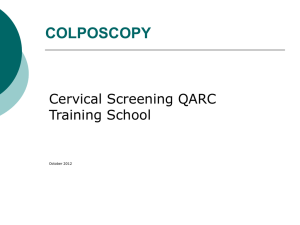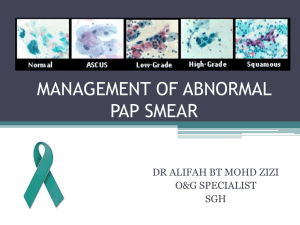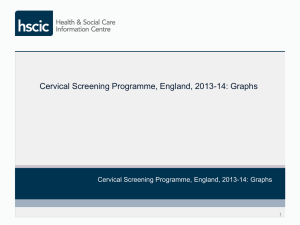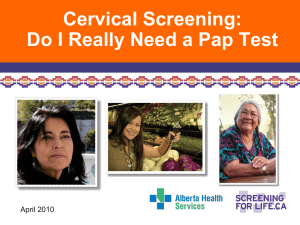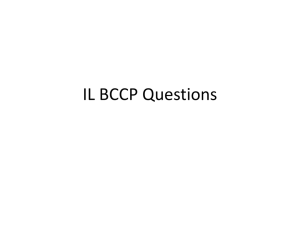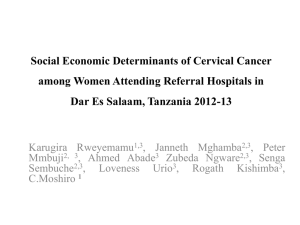Audit of Cervical Screening in Kiribati, Beiataua
advertisement
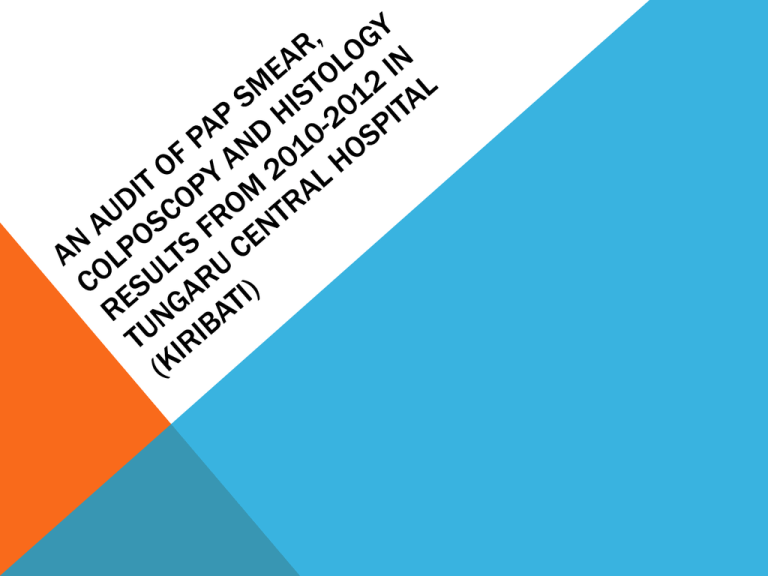
INTRODUCTION The population of Kiribati is 105520. From this population 26% are the reproductive age group. There is no cervical screening national policy in this country and papsmear are done sporadically through an outreach program. Pap smear in Kiribati started off as an opportunistic screening in 1996 In 2000-2008- based on the abnormal papsmear detected treatment such as total abdominal hysterectomy with high grade disease was done INTRODUCTION 2009-2012- the high grade smears and low grade smears were seen in the gynae clinic for colposcopy. This was the first management for high grade lesions introduced into the country High grade lesion- were treated with LLETZ, Cone biopsy and hysterectomy Low grade lesion had punch biopsy or repeat papsmear in 6/12months ASCUS, AGUS, AIS and cervical cancer were undergone colposcopy INTRODUCTION If the results were high grade then treatment were done as mentioned previously If low grade lesions were detected punch biopsy or repeat papsmear was done in 612months Cervical cancer patients- urgent referral was done or palliative care- referral to Fiji, Australia, India, Taiwan and New Zealand were done The total number of cervical cancers detected were 22 patients from 2010-2012. INTRODUCTION This showed an increase in trend in cervical cancer since 2005-2007. In 2005 there were 6 cervical cancer cases detected. In 2006 there were 8 cervical cancers detected and 14 in 2007 (TCH record 2012). These cases were admitted to the hospital however some of the patients did not come to the hospital and therefore the numbers were not recorded. There is a burden on the ministry of health’s budget to refer these patients abroad for chemotherapy and radiotherapy. Pap smear and colposcopy screening in this country is advocated in order to address this problem. In order to reduce cervical cancer there will be 15 cases of high grade lesion treated per year. INTRODUCTION The aim of this study was to conduct an audit of papsmear, colposcopy and histology results that were done in Tungaru central hospital from 2010-2012 Objectives 1- To audit the correlation between pap smear results with colposcopy results from 2010-2012 in Tungaru central hospital (Kiribati) 2- To audit the correlation between colposcopy results and histological results from 2010-2012 in Tungaru central hospital (Kiribati) LITERATURE REVIEW Cervical Cancer is one of the leading causes of women's death in developing countries(Word health organisation 2010). Pap smear is one of the cost effective tests in developing countries.It was introduced in 1943 by Papanicolau (Shadya 2008). The reliability of the test depends on an individual experience who collects and interprets the smear. In developed countries with good laboratory facilities 5-15% of abnormal smears may be reported normal( Everit et al, 2011). Women needs to be screened regularly . There is a need for a high coverage rate in order to detect high grade lesions. The incidence of high grade lesion is 15/1000 women (ibid) The gold standard of managing premalignant cytology is to have a directed punch biopsy. Multiple punch biopsies is sensitive to detect the high grade disease compared to single punch biopsy. In some developing countries high grade lesions detected under colposcopy were undergone a Large loop excision of the transformation zone or cone biopsy (Nazia and Safia 2011). LITERATURE REVIEW Colposcopy is a magnification tool that magnifies the cervix in order to detect premalignant lesions. With the application of the acetic acid this can cause the appearance of the cervix to be acetowhite or iodine negative on the abnormal cells. This provides an area for directed punch biopsy. The sensitivity of colposcopy to detect high grade lesions is 80-90% (Tan 2011) In Kiribati there is an estimation of 15 cases / year of high grade lesions to be treated in order to reduce cervical cancer. Sadhya ( 2008) found in her study that the accuracy of colposcopy is 82% and correlate better with the histology than Pap smear. She concluded that colposcopy is an excellent tool in evaluating cervical lesions. LITERATURE REVIEW Cervicitis or an inflammatory pap smear result can be considered as unimportant however it is associated with cervical intraepithelial lesion and infection with human Papilloma virus. Dasari, Kumar and Rajathani (2008) proved these findings with 150 women who had inflammatory pap smear and directed colposcopically biopsies that showed the two abnormalities. Comasesco et al., showed that the sensitivity of colposcopy in detecting low grade squamous intraepithelial lesion was 89% and the specificity is 52%. However two factors which need urgent colposcopy examination with a low grade lesions are increasing age of the patient and the presence of Human Papilloma virus (Kyrkiou 2010). Bolger et al found out that 15-20% of this group have a high grade lesion. This is a great concern in places where patients with such lesions are scheduled for a repeat pap smear in 6 months. Overtreatment was a concern when these patients had low grade lesion without the two aggravating risks factors (Kyrgiou 2012). Zarchi et al. (2011) found out that colposcopy and punch biopsy were very effective in detecting cervical cells abnormalities compared to pap smear alone. However Pretorius et al showed that despite a satisfactory colposcopy in a high grade lesion, endocervical curettage and random biopsies should be performed. This due to one of the participants in the study with invasive cervical cancer detected histologically from the endocervical curettage LITERATURE REVIEW The sensitivity of detecting CIN 2/3 was 56% with colposcopy. Luesley et.al found out that normal colposcopy in the presence of low grade cervical smear was associated with a very low risk of having developing high grade lesion. However two factors which need urgent colposcopic examination with a low grade lesion are increasing age of the patient and the presence of Human Papilloma virus (Kyrkiou 2010). Bolger et al found out that 15-20% of this group have a high grade lesion. In auditing a diagnostic colposcopy it looks into 2 levels: 1. a. Level 1- Documenting colposcopy Occasions of Service B. Maintaining skill level 2. a. Level 2- Reducing failure of diagnosis and to improve the diagnosis of high grade abnormalities LITERATURE REVIEW b. Reducing failure of a diagnosis and to improve the diagnosis of high grade abnormalities c. Ensuring Quality of cervical biopsies ( Colposcopy Quality improvement program 2010). METHODOLOGY This is a retrospective clinical audit All the data were extracted retrospectively from the hospital record in the gynae clinic in Tungaru Central Hospital and Victorian cytology unit from 2010-2012. The pap smear variables were high grade, low grade lesions, AGUS, ASCUS, AIS and cervical cancer. The colposcopy results were extracted from the colposcopy record book in Tungaru central gynaecology clinic.The colposcopy variables were high grade lesion, low grade lesion and normal. The histology results were extracted from Tungaru central laboratory record. The histology variables were high grade , low grade lesion, normal. METHODOLOGY The data were collected by the investigator and all complied in an excel spread sheet The correlation of this were shown on each table for each different years. Confidentiality was maintained as no one was accessed to the names of the patients except the investigator and the laboratory technicians that assisted the research. Analyses of data was done with the assistance of FNU health research unit director using epi data info. Audit of Correlation RESULTS Abnormal pap smears Colposcopy Histology results RESULTS: TOTAL NUMBER OF PAP SMEAR DONE AT DIFFERENT YEARS years VCS TCH total 2010 100 493 593 2011 196 676 872 2012 177 304 581 RESULTS Total number of pap smears with high grade lesions=103/2046=7.6% Turn up for colposcopy =156 Those patients with high grade pap smear that were turn up for colposcopy= 63 patients(61%) Total number of colposcopy with high grade lesions=34(22%) Total number of histology result with high grade lesion=n=29/52 number of histology available =56% total number excluded= 2= no histology 27visits 2x follow up 8 without any pap smears presents with irregular bleeding Total number of patients included 119 those who present to the colposcopy clinics High grade pap smears= 63(61%) WOMEN PRESENTED TO COLPOSCOPY CLINIC Year Total number Total no of punch biopsy taken Total no of LLETZ and cone biopsy 2010 57 24 11 2011 35 10 3 2012 64 8 3 PAP SMEAR-HIGH GRADE N=63 Normal Infection Low Grade High grade Colposcopy 13/63 (44%) 2/63(6.8%) 18/63(62%) 26/63(90%) Biopsy 3/29(10%) 1/29(3.4%) 10/29(34%) 18/29(62%) COLPOSCOPY-LOW GRADE N=31 High Grade Low grade Normal pap 63 14 167 biopsy 1 1 9 COLPOSCOPY WITH HIGH GRADE LESION N=34 High Grade Low grade Normal pap 66 1 - biopsy 29 1 2 AUDITING 54/63=85% was the total number of biopsies that were done. 95% of the biopsies should be achieved to reduce the risk of misdiagnosing the high grade lesion. 29/63=46%- Positive predictive value for the high grade lesions .Colposcopic findings should be correlated with histological finding in order to calculate the positive predictive value of colposcopy for high grade cervical abnormalities. 29/103=28% Predictive Value of high-grade cytology for high-grade histology, for each colposcopist DISCUSSION The study had shown that there were a total of 2046 pap smears done from the year 2010-2012. The high grade lesions detected were 102. Out of this number there was 63 who came for colposcopy. 39 of these patients did not turn up to colposcopy. The reasons were that these patients were staying on the outer islands and transportation was not available during the colposcopy team visits. Some of these women were staying on south Tarawa but did not aware of these visits. The total number of patients seen during these visits were 156. There were two patients with high grade lesions who did not have treatment. One of them went to Australia to visit her relatives while the other patient defaulted treatment. Twenty seven patients had more than 2 visits and eight had never have a pap smear but presented with abnormal irregular bleeding and per vaginal discharge. The total number of punch biopsy was 42. The total number of LLETZ biopsy was 14 and there were 3 cone biopsies done during the visits. DISCUSSION In auditing a colposcopy standard there were 3 levels of assessments. The first level was to document colposcopy occasions of service. Standard 1 record the number of colposcopy referrals seen each year which should be 100%.In this study all the patients referred for colposcopy were documented which met this standard criterion. Standard 2 dealt with maintaining skills level by undertaking 75 new colposcopy referrals in each 3 year period from the commencement of audit which was met by this study. There were more than 100 patients referred for colposcopy examinations from 20102012. The second level of auditing is reducing failure of diagnosis and to improve the diagnosis of high grade abnormalities. The first standard illustrated that biopsy of more than 95% of women with high grade cytological abnormalities should be performed. However this study did not meet this standard because not all the women with high grade lesions presented for colposcopy examination. Some of them had normal colposcopy examination therefore no biopsy taken. DISCUSSION Level 2 of auditing ensures that quality of cervical biopsies of more than 90% should be suitable for histological interpretation that this study did not meet. Thus only 42 colposcopy results with satisfactory biopsy results. In order to improve the accuracy of the diagnosis. Standard 3a is part of level 2 auditing which indicated that colposcopic findings should be correlated with histological findings in order to calculate the positive predictive value of colposcopy for high grade cervical abnormalities. This audit showed a 46% positive predictive value for high grade cervical abnormalities.The predictive value of high grade cytology for high grade histology for each colposcopist was 28%. LIMITATION 1. Bias 2. Patients defaulted for colposcopy and lletz treatment 3. Histology results were not available 4. Over reporting of pap smears 5. Diathermy effect which affected the histology result 6. Sample size was small RECOMMENDATIONS In order to improve this clinical audit, factors that needs to be improved are the improvement on the collection of pap smears, reviewing high grade pap smears by a cytologist before a colposcopy is conducted. Punch biopsy should be done in all high grade and low grade colposcopy lesions to improve the accuracy of the auditing process. LLETZ biopsy should be completely exiscing the cervical margin without any fragments. The diathermy coagulation should be adjusted in order to prevent artifacts. Histology results should be available efficiently so that correlation of high grade lesions were evaluated. National cervical cancer screening should be implemented to maintain an ongoing screening . Donations to the program so that women who have difficulty in reaching the place should be assisted. Annual auditing is essential in order to improve on pap smears, colposcopy and histology results. CONCLUSION Auditing pap smear, colposcopy and histology results are important in order to improve on the cervical cancer screening and increasing the detection rate of high grade lesions. This is important in order to improve recording system, diagnostic process during colposcopic examinations and the urgent need of the availability of the histology results for comparison. Cervical cancer prevention will be more successful if all these factors are considered.
